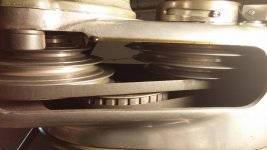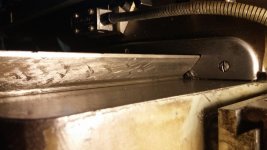whizbang
Plastic
- Joined
- Dec 8, 2013
- Location
- Michigan, USA
Hey,
So I just got this Bridgeport. The previous owner was really great about taking care of his equipment. He was a tool and die maker. Using some of the skills I learned in Richard King’s class I inspected the machine, but I am afraid I may have missed a few.
I put the magnetic bases for my dial indicators under the table to check the front saddle and found that it was 0 to .0008” out. On the back of the saddle and found that at the very back it was about 0.001”. These seem like great values but there is a noticeable difference at the ends when moving the table in the Y direction. It feels very tight at the end, most specifically towards the rear ( or + Y).
When I had the magnetic base on the knee and the indicator on the Y saddle and would press on the edge of the table to theoretically rotate it clockwise or counterclockwise from an aerial view, I would see up to .005” to .007” deflection with the lock virtually not on. When I really tighten the locks it dropped to about .0003” to .0005”.
And lastly when I had the magnetic base on the table and indicator on the Z ways, it was almost perfect. There was a consistent bounce back and forth of 0.0005” as the indicator crosses over scrapping marks but when stopped it was dead on at 0.
I have attached some photos and am look for some feedback regarding the re-build work on the ways. As you read for the most part it seems great, but the scrapping markings on the Y axis make me a little weary, especially with the tightness at the ends. Would all agree, that based on these specs and photos that this is a good machine despite not having chromed ways and it having a little sag in the Y on the knee. I do not plan (nor want to) rebuild this machine soon. I have other projects I need to get done and hopefully this machine helps me do so.




So I just got this Bridgeport. The previous owner was really great about taking care of his equipment. He was a tool and die maker. Using some of the skills I learned in Richard King’s class I inspected the machine, but I am afraid I may have missed a few.
I put the magnetic bases for my dial indicators under the table to check the front saddle and found that it was 0 to .0008” out. On the back of the saddle and found that at the very back it was about 0.001”. These seem like great values but there is a noticeable difference at the ends when moving the table in the Y direction. It feels very tight at the end, most specifically towards the rear ( or + Y).
When I had the magnetic base on the knee and the indicator on the Y saddle and would press on the edge of the table to theoretically rotate it clockwise or counterclockwise from an aerial view, I would see up to .005” to .007” deflection with the lock virtually not on. When I really tighten the locks it dropped to about .0003” to .0005”.
And lastly when I had the magnetic base on the table and indicator on the Z ways, it was almost perfect. There was a consistent bounce back and forth of 0.0005” as the indicator crosses over scrapping marks but when stopped it was dead on at 0.
I have attached some photos and am look for some feedback regarding the re-build work on the ways. As you read for the most part it seems great, but the scrapping markings on the Y axis make me a little weary, especially with the tightness at the ends. Would all agree, that based on these specs and photos that this is a good machine despite not having chromed ways and it having a little sag in the Y on the knee. I do not plan (nor want to) rebuild this machine soon. I have other projects I need to get done and hopefully this machine helps me do so.











 ). I Plan on taking the table and saddle off to get all the moly grease out and start using way oil.
). I Plan on taking the table and saddle off to get all the moly grease out and start using way oil.